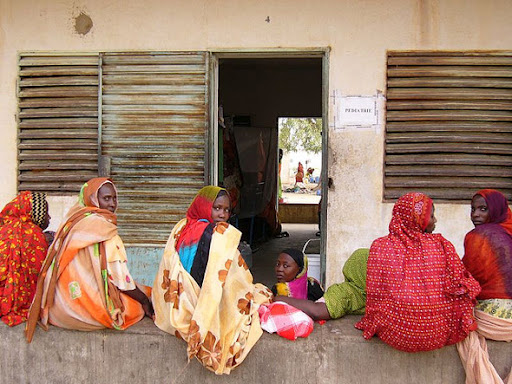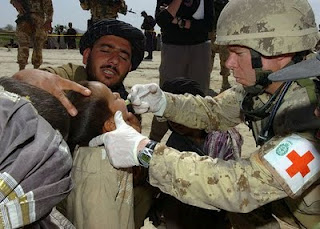-
NATO Says Don’t Fight the Planet
›Climate and security are under discussion today in Copenhagen at the Danish government’s side event, which brings together heavyweights such as NATO Secretary-General Anders Fogh Rasmussen, Swedish Foreign Minister Carl Bildt, African Union Chair Jean Ping, and Danish Foreign Minister Peter Stig Møller.
Fogh Rasmussen, the former prime minister of Denmark, delivered his remarks the new-fashioned way: today’s Huffington Post. He says NATO is ready to “do its part” by lowering its own carbon bootprint and responding to the increasing humanitarian challenges of a warmer world. He suggests the threat of climate change does not allow powerful institutions like NATO the luxury of sitting on the sidelines.
The post even includes this embedded “Climate Change and NATO” video with an unfortunate screen grab that reads “Fighting the Planet.” Not exactly a reassuring message for those who argue that framing climate change as a security issue will militarize the environment rather than green security (to paraphrase an excellent 1994 edited volume by Finn Jyrki Kakonen).
The video’s actual message is that some security threats can be fought and others shouldn’t be. Climate change will present a security threat, but “Fight the planet and we all lose,” says NATO. Even when the video makes all the right points, those pesky screen grabs can undermine your case! -
Tackling the Biggest Maternal Killer: How the Prevention of Postpartum Hemorrhage Initiative Strengthened Efforts Around the World
›On Friday, November 20th, 120 representatives from the maternal health community, the U.S. and around the world, gathered for an all day meeting at the Woodrow Wilson International Center for Scholars to discuss the report, Tackling the Biggest Maternal Killer: How the Prevention of Postpartum Hemorrhage Initiative Strengthened Efforts Around the World. This report describes the challenges and successes of the U.S. Agency for International Development (USAID) funded Prevention of Postpartum Hemorrhage Initiative (POPPHI).
The five-year POPPHI project was executed through the support of many partners whose main goal was to catalyze the expansion of active management of the third stage of labor (AMTSL) worldwide. The conference convened experts and advocates in the field of maternal health, to share best practices, new innovations, and future challenges for tackling maternal health’s leading killer: postpartum hemorrhage (PPH). Panelists included POPPHI field partners such as International Federation of Gynecology and Obstetrics, The International Confederation of Midwives, the World Health Organization, and international researchers.
Preventing Postpartum Hemorrhage: AMTSL
“We need to work on women postpartum–after birth we leave them,” argued Deborah Armbruster, POPPHI Project Director. Due to the fact that many women in the developing world give birth at home or in local clinics that lack the sufficient resources to prevent postpartum hemorrhaging, approximately 132,000 women die annually. Fortunately, effective and feasible interventions such as those established by POPPHI have been proven to save lives.
Active management of the third stage of labor (AMTSL) includes three factors that, when used together, can avert postpartum hemorrhage, including:1. Administration of uterotonic drugs (including oxytocin – the most preferred drug)
POPPHI’s “BOLD” Approach
2. Controlled cord contraction
3. Uterine massage after the delivery of the placenta
In collaboration with its partners, POPPHI implemented country-level and global programs to scale up AMTSL. Driven by the “BOLD” approach, Armbruster described how the initiative provided overall frameworks and approaches for strengthening PPH interventions by Building on evidence, Obtaining consensus, Linking partners, and Demonstrating to policymakers AMTSL’s feasibility.
Additionally, POPPHI provided learning materials such as toolkits, fact sheets, posters, and guides that were used to train providers and increase their use of AMTSL. A pilot project on Uniject (a single use needle pre-prepared with oxytocin) was also executed in Mali. Uniject was shown to be acceptable and successful with birth attendants there, and the study is now being replicated in Honduras.
Voices from the Field
Representatives from Argentina, Bangladesh, Ghana, Guatemala, Peru, and Mali presented their country results with the POPPHI project–concluding that the initiative served as a catalyst for upscaling AMTSL. Dr. Abu Jamil Faisel, Project Director and Country Representative of EngenderHealth in Bangladesh, discussed how the project helped to break through misperceptions that often prevented women from wanting to use misoprostol. In Ghana, policymakers worked with program managers and drug suppliers to register misoprostol in the country’s essential medicine list and updated guidelines to reflect best practices. While each country’s experiences were unique, the importance of partnerships was common to successfully upscaling AMTSL in all locations.
Partnerships: Critical to Success
Integrating maternal health indicators directly into program design is imperative to upscaling AMTSL, argued Niamh Darcy, Director of POPPHI Monitor and Evaluation. Additionally, Darcy argued that the success of POPPHI is due to the project’s emphasis in working with all levels of partners, particularly facility providers. Working with the supportive supervisors at facilities is necessary according to Darcy because this group is ultimately responsible for executing active management and recording project outcomes.
Identifying African experts who have taken leadership and ownership of the project has been instrumental in POPPHI successfully disseminating results at the regional, national and international levels argued Doyin Oluwole, Director, Africa’s Health in 2010. Partnering with local champions as well as policymakers has enabled many of the country projects to build capacity and upscale AMTSL.
Building on Lessons Learned
“A key lesson we have learned is that, when there is political commitment, AMTSL is rapidly scalable,” stated Lily Kak, Senior Maternal and Newborn Health Advisor, USAID. Changing behaviors and practices takes significant amount of resources and time commitment, however, POPPHI demonstrates that partnerships and research can be used to upscale AMTSL and change policies more efficiently.
Photo: Women wait outside a maternity ward in Chad. Courtesy of Flickr user mknobil. -
Climate Reporting Awards Live From COP; Revkin To Quit NYT
›It’s a good news/bad news day for climate-media watchers. The Earth Journalism Awards honor some of the best climate coverage from around the world, while arguably the world’s most respected climate reporter announces he’s leaving journalism.
Earth Journalism Awards
Tune in now to watch the Internews Earth Journalism Awards webcast live from Copenhagen. The spectacularly impressive winning entries span the globe from Kenya, Brazil, Pakistan, and Papua New Guinea.
Two top-notch stories illustrate how nuanced, in-depth reporting can compellingly and accurately portray climate-security links: Lisa Friedman’s 5-part series on Bangladesh for ClimateWire untangles the knotty problem of climate-induced migration, while William Wheeler writes in GOOD Magazine about the increasingly difficult role of Indus Water Treaty in mitigating conflict between India and Pakistan.
The 15 winners are blogging from the summit, as well 40 reporters from 26 developing nations, as part of the Climate Change Media Partnership.
Revkin Frustrated With Journalism; Will Leave NYT
On the bad news side, Yale Forum on Climate Change and Media announced this morning that Andrew Revkin, the NYT’s climate reporter, will leave the paper on December 21. He cites “frustration with journalism,” but will continue writing his popular DotEarth blog.
Maybe Revkin’s frustration is with the disintegration of environmental coverage in the mainstream media? The Internews winners demonstrate the high quality of climate coverage at niche publications like ClimateWire or funded by non-profits like the Pulitzer Center on Crisis Reporting.
Let’s hope Revkin finds a more comfortable home and continues his pioneering work on DotEarth, specifically his efforts to cover population, poverty, consumption, and development connections to climate. -
Climate and Security Hopes
›December 11, 2009 // By Geoffrey D. DabelkoThe Copenhagen climate negotiations have something for everyone. These mega-conferences attract all types, and the topical diversity of the side events is dizzying. We at the Wilson Center’s Environmental Change and Security Program are focused specifically on the climate and security discussions highlighted in an earlier New Security Beat post.
While I’m not able to join the 400+ participants expected at next week’s climate and security events, I do have some specific hopes for those discussions. And perhaps more importantly, I have hopes for steps after all the delegates go home. I try to capture my holiday wish list in this short video. -
Nobel Pursuits: Linking Climate Efforts With Development, Natural Resources, and Stability
›December 11, 2009 // By Geoffrey D. DabelkoThe only mention of climate change in President Obama’s Nobel Peace Prize acceptance speech falls squarely in the climate and security context. He introduces the climate imperative by highlighting natural resources and development connections to stability and human well-being.
In these two paragraphs, the President identifies the key communities that must come together, first in dialogue and then in cooperation, but who so commonly don’t: development, natural resources, health, climate, peacebuilding, and security.It is undoubtedly true that development rarely takes root without security; it is also true that security does not exist where human beings do not have access to enough food, or clean water, or the medicine and shelter they need to survive. It does not exist where children can’t aspire to a decent education or a job that supports a family. The absence of hope can rot a society from within.
Photo: President Barack Obama looks at the Nobel Peace Prize medal at the Norwegian Nobel Institute in Oslo, Norway, Dec. 10, 2009 (Official White House Photo by Pete Souza).
And that’s why helping farmers feed their own people — or nations educate their children and care for the sick — is not mere charity. It’s also why the world must come together to confront climate change. There is little scientific dispute that if we do nothing, we will face more drought, more famine, more mass displacement — all of which will fuel more conflict for decades. For this reason, it is not merely scientists and environmental activists who call for swift and forceful action — it’s military leaders in my own country and others who understand our common security hangs in the balance. -
Water Conflicts Enter the Fourth Dimension
›The Pacific Institute has just released an updated version of its renowned Water Conflict Chronology in a new interactive form. The online map depicts water conflicts from the Biblical flood to this year’s December 3 protest in Mumbai, pinpointing their location and chronological order. Pop-up text boxes provide the date, parties involved, basis for conflict, and hyperlinked references.
Since its founding in 1987, the project has continuously collected water conflict data “in an ongoing effort to understand the connections between water resources, water systems, and international security and conflict,” writes Pacific Institute President Peter Gleick in the San Francisco Chronicle.
But now, the data can also be visualized and manipulated in a table with citations, interactive timeline, or Google Earth map. Also of note is the project’s robust water and conflict bibliography search engine.
The Pacific Institute publishes The World’s Water, which offers a broad analysis of water resource trends, from conflict and scarcity, to implications for health and the impacts of climate change. At the Wilson Center launch of The World’s Water, Gleick talked to ECSP Director Geoff Dabelko about “peak water” (video). -
Climate and Security Comes to Copenhagen
›December 10, 2009 // By Geoffrey D. DabelkoThe Danish Ministry of Foreign Affairs is bringing climate and security links to the Copenhagen confab in Week Two of COP15. The foreign and security policy implications of climate change are appealing both analytically and politically for many players, albeit from very different points of reference (think Tuvalu versus Bangladesh versus the United States, for example). Others, of course, think it is rubbish.
Danish Foreign Minister Peter Stig Møller laid out his thinking back in September at a one-day conference at the ministry. MFA’s December 15th side event will feature former Danish PM and current NATO Secretary-General Anders Fogh Rasmussen, African Union Commission Chair Jean Ping, and Swedish Foreign Minister Carl Bildt. Some other big names are possible as well. You can RSVP for one of the 400 seats at MEK@UM.DK although registration may close today!
On December 17th, you can get another dose of climate and security talk at “Delivering Climate Security,” where the expert-level players will make their pitches. New Security Beat has video interviews with half of the panel’s speakers: Nick Mabey of E3G, Carol Dumaine of U.S. Department of Energy, and Cleo Paskal of Chatham House. Joining them will be Brigadier General Wendell Chris King (Ret.), dean of academics for the U.S. Army Command and General Staff College; Rear Admiral Neil Morisetti, the UK’s climate and energy security envoy, Major General Muniruzzaman (Ret.), who is president of the Bangladesh Institute for Peace and Security Studies.
So while the climate and security angle is not front-and-center in the negotiations on emissions targets or financing, it will have a hearing at this year’s ultimate climate forum. Let’s hope this attention extends beyond this month’s political crescendo, demonstrating an interest in the analytical links and their varied implications, rather than merely in the political expediency of climate security as slogan. -
U.S. Policy on Post-Conflict Health Reconstruction
›December 8, 2009 // By Calyn Ostrowski Stabilizing and rebuilding state infrastructure in post-conflict settings has been increasingly recognized as critical to aiding the population and preventing renewed conflict. The United States has increasingly invested in rebuilding health systems, and in some cases assisting in the delivery of health services for the first time.
Stabilizing and rebuilding state infrastructure in post-conflict settings has been increasingly recognized as critical to aiding the population and preventing renewed conflict. The United States has increasingly invested in rebuilding health systems, and in some cases assisting in the delivery of health services for the first time.
While global health concerns have recently received significant attention, as witnessed by President Obama’s Global Health Initiative, the importance of health system reconstruction to stabilization efforts remains unevenly recognized. On November 10, 2009, experts met at the Global Health Council’s Humanitarian Health Caucus to discuss investing in health services in the wake of war and the challenges of funding this investment.
“Deconstruction from violence extends beyond the time of war and often leads to severe damage of health infrastructure, decreased health workers, food shortages, and diseases…resulting in increased morbidity and mortality from causes that are not directly related to combat,” shared Leonard Rubenstein, a visiting scholar at Johns Hopkins School of Public Health. Rubenstein argued that while relieving suffering in post-conflict settings should be a sufficient reason to include health reconstruction in U.S. foreign policy, policymakers narrowly define rationales for engagement based on claims that investments increase peace and improve the image of the U.S. government.
Investing in Health Systems Builds State Legitimacy
The evidence for investing in health systems to deter future conflict is limited and this approach is dangerous, according to Rubenstein, because it distorts spending decisions and fails to consider comprehensive capacity development strategies. Additionally, the Department of Defense’s approach of “winning the hearts and minds” is too short-term and neither linked to “system-building activities that are effective and sustainable…nor consistent with advancing the health of the population,” he said.
Instead, Rubenstein recommended that the United States invest in health systems after conflict because it advances state legitimacy. Although additional evidence is necessary, Rubenstein maintains that the promotion of state legitimacy enhances the perception that the government is responding to their long-term needs and encourages local ownership and accountability. Developing health systems in post-conflict settings is complex and cannot be done quickly, he noted, and thus increased financial and human resource capacities will be essential.
Coordination and Transition Funding
“We need to recognize that the U.S. is not the only funder, as there are many stakeholders involved,” argued Stephen Commins, strategy manager for fragile states at the International Medical Corps. Commins argued that there is a “desperate need to coordinate donor funding … both within and across government systems, as well as an increased need for transparent donor tracking systems.”
As countries come out of conflict and start to gain government legitimacy, they need increased support to stabilize conflict and avoid collapse. Transition funding for health systems needs to support both short and long-term efforts, maintained Commins, but unfortunately the donors driving these timelines are often driven by self-interest, not the rights of the individual living in conflict.
Without a transparent donor tracking system, it is hard to demonstrate actual monetary disbursements versus commitments, so Commins called for a system that tracks allocations and spending in real time. These are not our countries, he argued, and responding to health systems in post-conflict settings should be tailored to the country’s needs, not the donor’s. He also called for increased research that describes, over time, the costs for rebuilding and transitioning from international NGO-driven systems to self-sustained governments.
Rebuilding Health Systems in Sudan
George Kijana, health coordinator in southern Sudan for the International Rescue Committee, discussed reasons for why Sudan’s health system remains poor five years after conflict. According to Kijana, the government in Southern Sudan has not been held accountable by its donors, leading to a breakdown in infrastructure and a lower quality of health workers.
Additionally, a majority of the available health data comes from non-state actors that are not easily accessible. Kijana shared that in order for Sudan to move forward, more research and data are needed to help target long-term capacity building projects, as well as short-term interventions that address infant and maternal mortality. While progress is slow, he pointed out encouraging signs of progress, as the Ministry of Health now recognizes their weaknesses and positively engages with its development partners such as the United Nations.
Photo: Romanian Patrol administers medical treatment to Afghan communities, courtesy of Flickr user lafrancevi.
 A Publication of the Stimson Center.
A Publication of the Stimson Center.





 Stabilizing and rebuilding state infrastructure in post-conflict settings has been increasingly recognized as critical to aiding the population and preventing renewed conflict. The United States has increasingly invested in rebuilding health systems, and in some cases assisting in the delivery of health services for the first time.
Stabilizing and rebuilding state infrastructure in post-conflict settings has been increasingly recognized as critical to aiding the population and preventing renewed conflict. The United States has increasingly invested in rebuilding health systems, and in some cases assisting in the delivery of health services for the first time.

